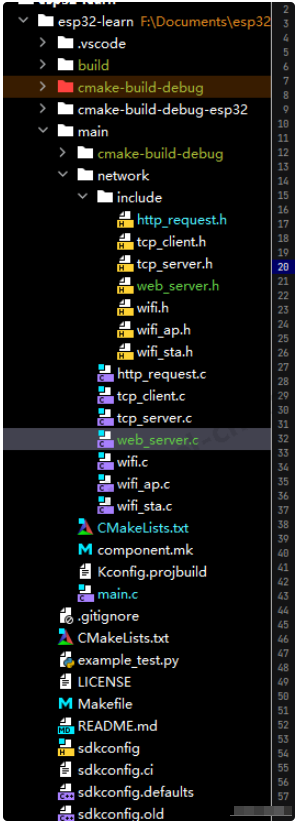

ESP32 IDF创建WEB SERVER的流程
描述
一、ESP32 IDF创建WEB SERVER的流程
1. 配置web服务器
在ESP-IDF中,Web服务器使用httpd组件实现。我们需要先创建httpd_config_t结构体,指定服务器的端口、最大并发连接数、URI匹配处理器等选项。然后,我们通过调用httpd_start函数来启动Web服务器。
httpd_config_t config = HTTPD_DEFAULT_CONFIG();
httpd_handle_t server = NULL;
// 设置服务器端口为80
config.server_port = 80;
// 创建HTTP服务器句柄
if (httpd_start(&server, &config) != ESP_OK) {
printf("Error starting server!\\n");
return;
}
在这个示例中,我们首先使用HTTPD_DEFAULT_CONFIG宏创建默认的Web服务器配置。接着,我们将服务器端口设置为80,创建HTTP服务器句柄,并启动Web服务器。
2. 注册 URI处理器
在Web服务器启动后,我们需要为不同的URI注册处理器函数。当Web服务器接收到请求时,会根据请求的URI选择相应的处理器函数进行处理。在ESP-IDF中,我们可以使用
httpd_register_uri_handler函数注册URI处理器。该函数的原型如下:
esp_err_t httpd_register_uri_handler(httpd_handle_t hd, const httpd_uri_t *uri)
其中,hd参数为HTTP服务器句柄;uri参数为包含URI路径、HTTP方法、处理函数等信息的结构体指针。例如:
static esp_err_t hello_get_handler(httpd_req_t *req)
{
char resp_str[64];
httpd_req_get_url_query_str(req, resp_str, sizeof(resp_str));
printf("query string: %s\\n", resp_str);
httpd_resp_send(req, "Hello, world!", HTTPD_RESP_USE_STRLEN);
return ESP_OK;
}
httpd_uri_t hello = {
.uri = "/hello",
.method = HTTP_GET,
.handler = hello_get_handler,
.user_ctx = NULL
};
if (httpd_register_uri_handler(server, &hello) != ESP_OK) {
printf("Error registering URI handler!\\n");
return;
}
3. 实现 URI处理器函数
在注册URI处理器后,我们需要实现对应的处理器函数。URI处理器函数的原型为:
typedef esp_err_t (*httpd_uri_func_t)(httpd_req_t *req);
其中,req参数为指向HTTP请求信息的结构体指针,包含了请求的各种参数和数据。
4. 处理HTTP请求
在URI处理器函数中,我们可以通过HTTP请求信息结构体指针httpd_req_t获取HTTP请求的各种参数和数据。以下是一些常用的HTTP请求处理函数:
-
httpd_req_get_hdr_value_str:获取HTTP请求头中指定字段的值(字符串格式)
-
httpd_req_get_url_query_str:获取HTTP请求URL中的查询参数(字符串格式)
-
httpd_query_key_value:解析HTTP请求URL中的查询参数,获取指定参数名的值(字符串格式)
-
httpd_req_recv:从HTTP请求接收数据
-
httpd_req_send:发送HTTP响应数据
-
httpd_resp_set_type:设置HTTP响应内容的MIME类型
-
httpd_resp_send_chunk:分块发送HTTP响应数据。
例如,以下是一个URI处理器函数的示例,用于处理/echo路径的POST请求:
static esp_err_t echo_post_handler(httpd_req_t *req)
{
char buf[1024];
int ret, remaining = req->content_len;
// 从HTTP请求中接收数据
while (remaining > 0) {
ret = httpd_req_recv(req, buf, MIN(remaining, sizeof(buf)));
if (ret <= 0) {
if (ret == HTTPD_SOCK_ERR_TIMEOUT) {
// 处理超时
httpd_resp_send_408(req);
}
return ESP_FAIL;
}
// 处理接收到的数据
// ...
remaining -= ret;
}
// 发送HTTP响应
httpd_resp_set_type(req, HTTPD_TYPE_TEXT);
httpd_resp_send(req, "Received data: ", -1);
httpd_resp_send_chunk(req, buf, req->content_len);
httpd_resp_send_chunk(req, NULL, 0);
return ESP_OK;
}
5. 处理web socket连接
除了支持HTTP请求外,ESP-IDF的Web服务器还支持WebSocket连接。WebSocket是一种基于TCP的协议,可以提供双向通信功能。在ESP-IDF中,我们可以使用httpd_ws_frame_t结构体表示WebSocket帧,使用httpd_ws_send_frame_async函数异步发送WebSocket帧。
要处理WebSocket连接,我们需要为WebSocket URI注册专门的处理器函数,并在该函数中处理WebSocket连接的各种事件。
6. 注册 URI 处理函数
创建好HTTP服务器后,需要注册URI处理函数,以便处理客户端发送的请求。URI处理函数需要实现在HTTP请求中指定的URI。
在ESP-IDF中,可以使用
httpd_register_uri_handler()函数注册URI处理函数。该函数需要传入一个httpd_uri_t结构体作为参数,该结构体包含了URI路径和处理函数的信息。
例如,下面的代码注册了一个处理根目录的URI处理函数:
httpd_uri_t uri = {
.uri = "/",
.method = HTTP_GET,
.handler = hello_get_handler,
.user_ctx = NULL
};
httpd_register_uri_handler(server, &uri);
上面的代码注册了一个HTTP GET方法,URI路径为“/”的处理函数hello_get_handler。当客户端请求根目录时,HTTP服务器将调用hello_get_handler函数处理请求。
7. 启动HTTP服务器
在所有的URI处理函数都被注册后,可以调用httpd_start()函数启动HTTP服务器。
httpd_start(&server);
8. 发送响应
在URI处理函数中,可以使用httpd_resp_send()函数将响应发送回客户端。该函数需要传入一个httpd_req_t结构体作为参数,该结构体表示HTTP请求和响应。
例如,在上面的hello_get_handler处理函数中,可以使用httpd_resp_send()函数将“Hello, World!”字符串作为响应发送回客户端:
static esp_err_t hello_get_handler(httpd_req_t *req)
{
const char* resp_str = "Hello, World!";
httpd_resp_send(req, resp_str, strlen(resp_str));
return ESP_OK;
}
9. 关闭 http 服务
使用httpd_stop()函数,该函数用于停止HTTP服务并释放所有资源。
// 创建HTTP服务
httpd_handle_t server = NULL;
httpd_config_t config = HTTPD_DEFAULT_CONFIG();
httpd_start(&server, &config);
// 关闭HTTP服务
httpd_stop(server);
二、本要主要使用API的说明
1. httpd_register_uri_handler
用于将HTTP请求的URI路由到处理程序。这个函数接收两个参数:httpd_handle_t类型的HTTP服务器句柄和httpd_uri_t类型的URI配置。
2. httpd_handle_t
httpd_handle_t是HTTP服务器的一个句柄,它是通过httpd_start函数创建的。而httpd_uri_t则定义了HTTP请求的URI信息,包括URI路径、HTTP请求方法和处理函数等。
3. httpd_query_key_value获取变量值
httpd_query_key_value 用于从查询字符串中获取指定键的值。查询字符串是指URL中?后面的部分,包含多个键值对,每个键值对之间使用&分隔。例如,对于以下URL:
http://192.168.1.1/path/to/handler?key1=value1&key2=value2
获取其中的:
esp_err_t httpd_query_key_value(const char *query, const char *key, char *buf, size_t buf_len);
这是一个使用示例:
char query_str[] = "key1=value1&key2=value2";
char key[] = "key1";
char value[16];
if (httpd_query_key_value(query_str, key, value, sizeof(value)) == ESP_OK) {
printf("value=%s\\n", value);
} else {
printf("key not found\\n");
}
4. 获取get参数示例
下面定义的 handler 演示了如何从请求参数里解析 字符串param1和整型变量param2:
esp_err_t index_handler(httpd_req_t *req)
{
char* query_str = NULL;
char param1_value[10] = {0};
int param2_value=0;
query_str = strstr(req->uri, "?");
if(query_str!=NULL){
query_str ++;
httpd_query_key_value(query_str, "param1", param1_value, sizeof(param1_value));
char param2_str[10] = {0};
httpd_query_key_value(query_str, "param2", param2_str, sizeof(param2_str));
param2_value = atoi(param2_str);
}
char resp_str[50] = {0};
snprintf(resp_str, sizeof(resp_str), "param1=%s, param2=%d", param1_value, param2_value);
httpd_resp_send(req, resp_str, strlen(resp_str));
return ESP_OK;
}
5. 获取post参数示例
下面的示例代码中根据httpd_req_t的content_len来分配一个缓冲区,并解析请求中的POST参数:
esp_err_t post_demo_handler(httpd_req_t *req)
{
char post_string[64];
int post_int=0;
if (req->content_len > 0)
{
// 从请求体中读取POST参数
char *buf = malloc(req->content_len + 1);
int ret = httpd_req_recv(req, buf, req->content_len);
if (ret <= 0)
{
// 接收数据出错
free(buf);
return ESP_FAIL;
}
buf[req->content_len] = '\\0';
// 解析POST参数
char *param_str;
param_str = strtok(buf, "&");
while (param_str != NULL)
{
char *value_str = strchr(param_str, '=');
if (value_str != NULL)
{
*value_str++ = '\\0';
if (strcmp(param_str, "post_string") == 0)
{
strncpy(post_string, value_str, sizeof(post_string));
}
else if (strcmp(param_str, "post_int") == 0)
{
post_int = atoi(value_str);
}
}
param_str = strtok(NULL, "&");
}
free(buf);
}
// 将结果打印输出
printf("post_string=%s, post_int=%d\\n", post_string, post_int);
// 返回成功
httpd_resp_send(req, NULL, 0);
return ESP_OK;
}
httpd_uri_t post_uri = {
.uri = "/post",
.method = HTTP_POST,
.handler = post_demo_handler,
.user_ctx = NULL
};
三、基本用法完整示例
接前文的项目代码示例,项目结构如下:

本文主要是使用其中的web_server.c文件。
1. 加载http_server模块
在 CMakeLists.txt里写上 :
idf_component_register(
REQUIRES "esp_http_server"
)
2. 建立 web_server.h 头文件
#ifndef ESP32_LEARN_WEB_SERVER_H
#define ESP32_LEARN_WEB_SERVER_H
void http_server_task(void *pvParameters);
#endif //ESP32_LEARN_WEB_SERVER_H
3. web_server.c文件实现
#include "include/web_server.h"
#include
#include "freertos/FreeRTOS.h"
#include "freertos/task.h"
#include "esp_log.h"
#include "esp_system.h"
#include "esp_netif.h"
#include "esp_http_server.h"
#include "string.h"
/* Define the server port number */
#define SERVER_PORT 80
/* Define the routes for the web server */
const char *INDEX_HTML = "Hello, world";
/* Define the handler for the HTTP requests */
esp_err_t index_handler(httpd_req_t *req)
{
httpd_resp_send(req, INDEX_HTML, strlen(INDEX_HTML));
return ESP_OK;
}
/* Define the HTTP server configuration */
httpd_uri_t index_uri = {
.uri = "/",
.method = HTTP_GET,
.handler = index_handler,
.user_ctx = NULL
};
/* Define the HTTP server task */
void http_server_task(void *pvParameters)
{
httpd_handle_t server = NULL;
httpd_config_t config = HTTPD_DEFAULT_CONFIG();
config.server_port = SERVER_PORT;
/* Start the HTTP server */
if (httpd_start(&server, &config) == ESP_OK) {
/* Register the routes */
httpd_register_uri_handler(server, &index_uri);
ESP_LOGI("HTTP_SERVER", "Server started");
}
/* Loop to keep the task running */
while (1) {
vTaskDelay(1000 / portTICK_PERIOD_MS);
}
}
4. main.c 创建任务开启web server
#include
#include "freertos/FreeRTOS.h"
#include "freertos/task.h"
#include
#include "network/include/wifi.h"
#include "network/include/wifi_sta.h"
#include "network/include/wifi_ap.h"
#include "network/include/web_server.h"
static const char *TAG = "main";
void app_main()
{
ESP_LOGE(TAG, "app_main");
// 初始化NVS存储区
esp_err_t ret = nvs_flash_init();
if (ret == ESP_ERR_NVS_NO_FREE_PAGES || ret == ESP_ERR_NVS_NEW_VERSION_FOUND) {
ESP_ERROR_CHECK(nvs_flash_erase());
ret = nvs_flash_init();
}
ESP_ERROR_CHECK(ret);
// Wi-Fi初始化
ESP_LOGI(TAG, "Wi-Fi initialization");
wifi_initialize();
wifi_init_softap();
/* Start the HTTP server task */
xTaskCreate(http_server_task, "http_server_task", 4096, NULL, 5, NULL);
while (1) {
vTaskDelay(pdMS_TO_TICKS(500));
}
}
-
VSCode + ESP-IDF环境下给ESP32-S3项目添加头文件2025-11-28 1010
-
[esp32教程] 5、UART使用2023-06-13 8918
-
[esp32教程] 4、LEDC使用2023-06-03 6319
-
[esp32教程]2、按键中断2023-05-05 8537
-
【esp32教程】0、环境搭建2023-04-21 5365
-
ESP32 之 ESP-IDF 教学(十)—— 电机控制器(MCPWM)2022-01-14 2780
-
ESP32 之 ESP-IDF 教学WiFi篇(一)—— WiFi两种模式2022-01-13 2768
-
ESP32 之 ESP-IDF 教学(八)—— 模数转换器(ADC)2021-12-22 2783
-
ESP32 之 ESP-IDF 教学(五(1))——ESP-IDF的CMake 构建系统(Build System)2021-12-16 1740
-
ESP32 之 ESP-IDF 教学(三)——通用硬件定时器(Timer)2021-11-26 3157
-
启明云端分享|ESP32-S3如何实现tcp_client和tcp_server2021-09-24 6396
-
启明去端分享| ESP32-S3如何实现tcp_client和tcp_server2021-09-07 8180
-
浅析Zephyr在ESP32上的启动流程2021-06-07 6799
全部0条评论

快来发表一下你的评论吧 !

